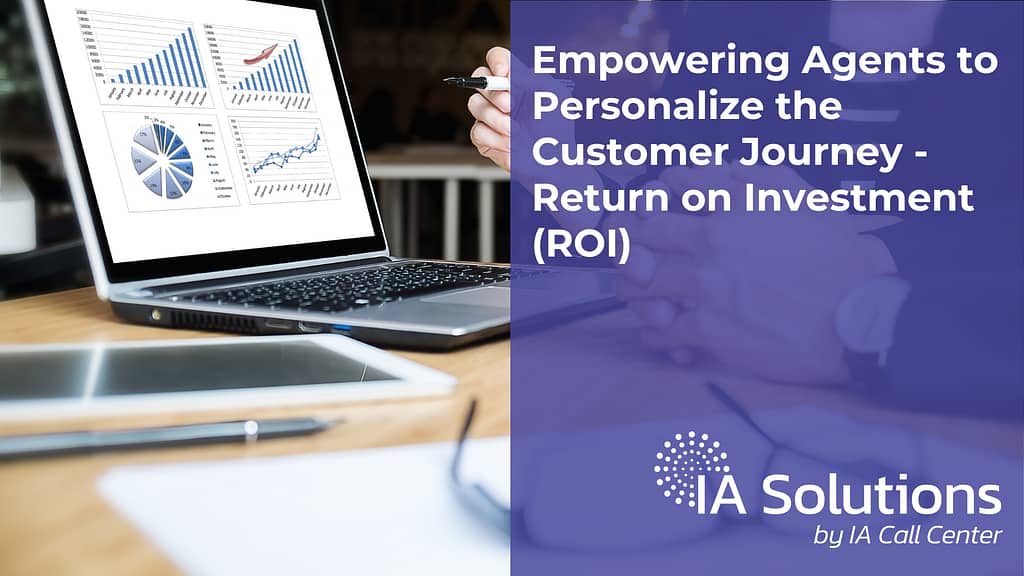Empowering Agents to Personalize the Customer Journey – Return on Investment (ROI)
Rather listen to the audio for this post instead? Click the play button below to hear it now.
(Note – This is the tenth and last post in our 10-part series, “Empowering Agents to Personalize the Customer Journey.” If you missed the last one, “Changes and Improvements,” please click here to view it now. We will continue to post insightful articles regarding the customer journey every week. Therefore, please be sure to sign up to follow our blog to receive updates when we post new articles.) To view all the articles in the current series, please click here.
Introduction
The customer journey has always been a focal point in business. However, in today’s digital market place, personalization has become more critical than ever. As customers expect seamless, tailored experiences across multiple channels, businesses must adapt to meet their needs. Therefore, the intent of this article is to explore the significance of personalization in the modern market, the customer journey, and the role of omnichannel implementation with a focus on the return on investment (ROI).
In this article, we will discuss personalization techniques, data privacy, technology solutions, implementation strategies, measuring success, and continuous improvement. We will discuss these techniques as they relate to improving customer experiences and your bottom line.
The Importance of Personalization in Today’s Market
Now, more than ever, your business must differentiate itself by offering unique, relevant experiences to your customers. If you don’t, one or more of your competitors will!
According to a study by Accenture, three out of four customers are more likely to purchase from a retailer that is familiar with their name, suggests options based on their past purchases, or knows what they have bought in the past. Personalizing interactions encourages customer loyalty, increases sales, and enhances customer satisfaction. Similarly, other research shows that personalization can generate up to an 8x return on the amount spent on marketing and boost sales by 10% or more.
Understanding the Customer Journey
The customer journey encompasses all the touchpoints a customer encounters, from awareness to post-purchase support. Therefore, by understanding the various stages of the customer journey, your business can identify opportunities for personalization and ensure they meet customers’ expectations at each step.
Mapping the customer journey can also help in identifying gaps and areas for improvement, further enhancing customers’ overall experience. A study by McKinsey & Company showed that companies that fully invested in understanding the customer journey experienced a 20-30% increase in customer satisfaction and a 10-15% reduction in service costs.

Mapping the Customer Journey
Mapping the customer journey involves identifying and analyzing the various touchpoints and interactions that customers have with your brand, from awareness to purchase and beyond. By understanding the customer journey, your business can identify opportunities to deliver personalized experiences that resonate with customers and drive engagement. If you’re not familiar with creating an effective customer journey map, here is an excellent article on the process from HubSpot.
Identifying Pain Points
Identifying pain points within the customer journey is crucial for optimizing the overall experience of your customers. Pain points might include things such as long wait times, confusing website navigation, or limited support options. By addressing these issues and implementing personalized solutions, your business will improve customer satisfaction and loyalty.
The Role of Omnichannel Implementation
Establishing an effective omnichannel approach is key to delivering a consistent, personal experience across all channels. Blending online and offline channels enables you to develop a single brand experience that is both consistent and tailored to each customer. This technique not only heightens customer satisfaction but also boosts engagement and sales. Results from a Harvard Business Review study showed that omnichannel customers had an average of 4% more in-store spending and 10% more online spending than single-channel customers.
Creating a Seamless Experience
A successful omnichannel implementation means providing a consistent and seamless experience across all customer touchpoints, including in-store, online, mobile, and social channels. By adopting an omnichannel approach, your business ensures that personalization efforts are cohesive and effective across all channels, enhancing the overall customer experience.
Integrating Data and Insights
An effective omnichannel implementation requires the integration of data and insights from various channels to create a holistic view of each customer. This enables your business to deliver personalized experiences based on a customer’s preferences, behaviors, and interactions across all channels.
Enhancing Customer Engagement and Loyalty
Effective omnichannel personalization leads to increased customer engagement and loyalty. Therefore, crafting a well-executed omnichannel strategy allows you to track the effectiveness of your personalization efforts and make data-driven decisions to optimize their approach.
Personalization Techniques
Personalizing the customer journey never stops; it’s a continuous process. For this reason, your company needs to remain open to changes and improvements and finding better techniques for customizing the customer journey. Keeping this in mind, here are some personalization techniques that your business can use:
Segmentation: Categorizing customers based on demographic, behavior, and preference. A study by Instapage showed that emails with personalization had an open rate and click-through rate that was up to 300% greater than emails without personalization.
Personalized Suggestions: Making use of customer data to provide relevant product or service recommendations. An Amazon survey revealed that tailored suggestions led to a 35% boost in sales.
Tailored Content: Creating content that is tailored to specific customer interests and preferences. According to a survey from Demand Metric, 80% of marketers reported that content tailored to their audience was more successful than non-personalized content.
Dynamic Pricing: Price changes based on customer actions and market conditions. Bain & Company conducted a study which found that companies using dynamic pricing saw their sales volume almost double when compared to those that do not.
Segmentation and Targeting
As stated before, segmentation is the act of splitting customers into different clusters based on similar characteristics, such as age, behaviors, or preferences. Aiming marketing efforts to certain demographics to deliver appropriate and tailored content is known as targeting. Creating targeted marketing messages through segmentation and targeting can help your business to engage and convert customers.
Dynamic Content and Messaging
Content that is tailored to user behavior, preferences, or demographics is called dynamic content. Introducing dynamic content and messaging can provide your business with the ability to give customers personalized experiences in real-time. Giving customers personalized information, offers, and recommendations leads to higher customer delight and loyalty.

Customer Data and Privacy
When your company collects and makes use of customer data, it is important to balance personalization and privacy. Making sure you comply with data protection regulations such as the GDPR and CCPA is essential. According to a Cisco report, companies that devoted resources to data privacy gained an average ROI of 2.7x on their privacy investments.
Collecting and Managing Customer Data
Personalizing the customer journey effectively requires the gathering and managing of customer data. This data can range from demographic details, past purchases, browsing habits, and beyond. Therefore, your company must take proper steps to acquire, hold, and manage customer data in a secure and responsible way to preserve customer trust and comply with data privacy laws.
Balancing Personalization and Privacy
It is important to remember that while personalization can make the customer experience better, you must also be aware of customer privacy needs. Therefore, taking steps such as strengthening data security, having customers agree to data collection, and providing straightforward privacy policies that outline how customer data is used and shielded are all essential.
Technology Solutions for Personalization
Investing in technology solutions that enable personalization is vital if you want your business to stay competitive. Taking advantage of artificial intelligence (AI,) machine learning (ML,) and data analytics tools will allow your business to analyze customer behavior, predict preferences, and deliver personalized experiences. A Boston Consulting Group survey showed that companies that apply AI and ML for their personalization strategies experience a 6-10% rise in sales, two to three times higher than those of other companies.
Customer Relationship Management (CRM) Systems
CRM systems play a key role in organizing customer data and making personalization efforts achievable. These platforms can compile and preserve customer info, watch over customer interactions, and divide customers into separate groups. Employing CRM systems, your company can get a comprehensive view of all your customers and present individualized experiences that bolster engagement and devotion.
Marketing Automation Platforms
Software tools that automate marketing processes, like email campaigns, social media postings, and lead nurturing, are called marketing automation platforms. Platforms like these are great for delivering personalized content to customers based on their preferences, behaviors, and interactions. Using marketing automation in your personalization techniques can help you save time and resources while improving the customer journey.
Artificial Intelligence (AI) and Machine Learning
AI and machine learning technologies can analyze vast amounts of customer data to identify patterns and trends, enabling your business to deliver highly targeted and relevant experiences. AI-powered personalization tools can predict customer preferences, recommend products or content, and even automate customer support interactions, leading to improved customer satisfaction and loyalty.
Implementing Personalization Strategies
Successfully implementing personalization strategies involves integrating customer data across all channels, training staff, and investing in technology solutions. A Forrester study showed that businesses that adopted a customer-obsessed operating model achieved an average ROI of 27%. Although the study is somewhat dated, all the data in that study are still relevant today. In fact, the ROI numbers for companies that implement personalization strategies are reported to be much higher these days in several smaller, lesser-known studies.
Aligning With Business Objectives
When implementing personalization strategies, your business must ensure that efforts align with your overall objectives and goals. This could involve increasing customer retention, generating revenue growth, or boosting customer satisfaction. Tuning personalization efforts to your business objectives makes sure that investments produce actual results and positively impact the company’s bottom line.
Employee Training and Support
For personalization efforts to be successful, you must equip your agents with the skills, knowledge, and autonomy needed to execute these strategies effectively. Consequently, you must offer comprehensive training and continual support for agents and employees to help carry out the successful adoption of personalization tools and technologies, making sure that customer experiences are regularly improved. Periodical reviewing phrasing and scripts used by agents can be beneficial as well.

Measuring Success
To measure the ROI of personalization efforts, your business should establish key performance indicators (KPIs) that align with your goals. Metrics such as conversion rate, average order value, customer lifetime value, and customer satisfaction can help you determine the effectiveness of personalization initiatives. An article by Inc. revealed that 79% of marketers who exceeded their revenue goals had a documented personalization strategy. The same study quoted by Inc. shows that only 8% of marketers, who had a personalization strategy, did not meet their revenue goals.
Key Performance Indicators (KPIs)
Determining how well personalization efforts are working is a must in understanding their impact on the success of your business. Key performance indicators (KPIs), such as conversion rates, customer retention rates, and average order value, can help your business track the effectiveness of personalization efforts and identify any areas for improvement. By regularly monitoring KPIs, your business can make data-driven decisions to optimize personalization strategies and drive continuous improvement.
Personalize the Customer Journey: ROI
Determining the Return On Investment (ROI) of personalization attempts is key to ascertaining their value and justifying additional investment in these endeavors. Your company can work out the Return on Investment by weighing up the costs of personalization against the advantages, such as increased sales, customer loyalty and greater customer satisfaction. A positive return on investment indicates personalization efforts are yielding tangible results and contributing to the company’s financial success.

Balancing Personalization and Customer Expectations
While personalization can enhance the customer experience, your business still must balance it with respecting customers’ privacy and preferences. Consequently, providing customers with options to control their data and adjust their personalization settings is critical to maintaining trust and loyalty. A recent PwC trust survey revealed that about 80% of customers are more likely to trust a company that provides them with control over their data and personalization settings.
Respecting Customer Preferences
While personalization can enhance the customer experience, it is important to respect customer preferences and boundaries as well. Overly intrusive or aggressive personalization tactics can (and will) alienate customers and damage their trust in your brand. Therefore, your business must carefully consider how it implements personalization techniques to ensure that they deliver relevant and valuable experiences without compromising customer privacy or crossing boundaries.
Continuous Improvement and Optimization
Personalization efforts are an ongoing process that involves analyzing customer feedback, measuring success, and adjusting accordingly. Thus, constantly refining and optimizing personalization processes can lead to a higher ROI and improved customer satisfaction. For instance, a Gartner study found that companies that continuously improve their personalization efforts can see up to a 15% increase in profits and about a 20% increase in customer satisfaction.
Summary
In this article, Personalize the Customer Journey – Return on Investment (ROI), we start by looking at the customer journey and the essential points of contact, emphasizing the importance of mapping and understanding each stage of the journey. We then discuss the role of omnichannel implementation and how it can unify and optimize customer experiences across various channels.
Furthermore, we outline personalization techniques, such as customer segmentation, targeting, and machine learning, as well as the importance of protecting customer data and complying with data privacy regulations.
As we progress through the article, we address the crucial technology solutions that can facilitate personalization, including CRM systems, marketing automation platforms, and AI-powered chatbots. We also cover the implementation of personalization strategies by aligning them with business objectives and involving stakeholders at all levels.
The article also emphasizes the importance of measuring success by tracking key performance indicators (KPIs) and adopting a continuous improvement mindset. Finally, we explore the delicate balance between personalization and customer expectations, emphasizing the need to respect customer privacy and manage potential trade-offs.
Overall, this article offers a comprehensive guide to help businesses effectively implement personalization strategies, ultimately leading to improved customer experiences and increased ROI.
As technology continues to evolve, your business must remain agile and flexible enough to adapt to new customer behaviors and preferences. By keeping this post handy, your business can stay informed and up-to-date on the latest trends and best practices in omnichannel implementation.
You’ve reached the end of the article, “Empoweing Agents to Personalize the Customer Journey – Return on Investment (ROI). Thank you for reading.
Get More Information
This is the last post in our Empowering Agents to Personalize the Customer Journey series. If you have not read the previous posts in this series, we encourage you to do so. If you’re looking for more information on how personalizing the customer journey with omnichannel can improve your bottom line, please review the posts in this series by clicking here.















